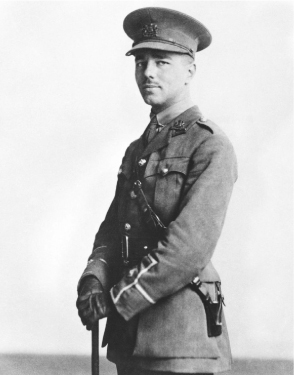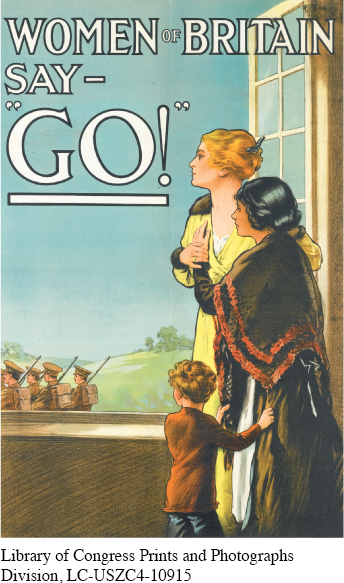8.6
Dulce et Decorum Est
Wilfred Owen

Wilfred Owen (1893–
KEY CONTEXT Owen’s work is in direct contrast to the patriotism that normally surrounds war; one of his poems, “Anthem for Doomed Youth,” begins with this question and answer:
What passing-
Only the monstrous anger of the guns.
Only the stuttering rifles’ rapid rattle
Can patter out their hasty orisons.1
This piece, Dulce et Decorum Est, written while Owen was in the hospital recuperating from shell shock (now called post-
567


What argument is this poster making, both visually and verbally? What appeals does it rely upon? How is this argument similar to or different from the argument Owen cites in the final lines of his poem?
Bent double, like old beggars under sacks,
Knock-
Till on the haunting flares we turned our backs
And towards our distant rest began to trudge.
5 Men marched asleep. Many had lost their boots
But limped on, blood-
Drunk with fatigue; deaf even to the hoots
Of tired, outstripped Five-
Gas! Gas! Quick, boys! — An ecstasy of fumbling,
10 Fitting the clumsy helmets just in time;
But someone still was yelling out and stumbling,
And flound’ring like a man in fire or lime3 —
Dim, through the misty panes and thick green light,
As under a green sea, I saw him drowning.
15 In all my dreams, before my helpless sight,
He plunges at me, guttering, choking, drowning.
If in some smothering dreams you too could pace
Behind the wagon that we flung him in,
And watch the white eyes writhing in his face,
20 His hanging face, like a devil’s sick of sin;
If you could hear, at every jolt, the blood
Come gargling from the froth-
Obscene as cancer, bitter as the cud
Of vile, incurable sores on innocent tongues, —
25 My friend, you would not tell with such high zest
To children ardent for some desperate glory,
The old Lie: Dulce et decorum est
Pro patria mori.
Understanding and Interpreting
What is the “old Lie” (ll. 27–
28)? According to the speaker, who tells this lie and to whom? Why is it an “old” lie? How would you characterize the speaker? What are his motivations for focusing on the details he does?
Throughout the poem, there is a sense of helplessness in the face of the overwhelming brutality of war. Identify and explain places where this helplessness is demonstrated.
568
Analyzing Language, Style, and Structure
Trace the speaker’s use of pronouns in this poem. It starts with “we,” moves to “I” and “me” in the middle, and finally concludes with “you.” How does this shift in pronouns reflect the poem’s theme?
The speaker uses a stark, unflinching, and bitter tone toward war. Choose at least two similes and explain how those similes establish the intended tone.
Most of the stanzas in the poem are six or more lines, except the third stanza, which is only two lines long. What does this choice of a shorter stanza reveal about the speaker?
How does the strict and formal A/B rhyme scheme create tension with the poem’s graphic and chaotic descriptions of war?
Connecting, Arguing, and Extending
It’s clear that in stanza 3, the speaker is suffering from what people in Owen’s time called “shell shock,” though today we call it “post-
traumatic stress disorder.” Conduct brief research on how doctors have improved their diagnoses and treatments of PTSD in the years since World War I. What is the current recommended treatment? The speaker of the poem calls the idea that is sweet and honorable to die for your country “the old Lie.” Write an argument about whether Owen was right or wrong to call it a lie. Was Owen just a product of an extremely brutal war? Are there times when the lie is true?
If you were to listen to a reading of “Dulce et Decorum Est” with your eyes closed, you could probably picture it in your mind as if it were a movie because of the graphic details Owens uses. Draw a storyboard of at least three shots or frames of a film that would capture the imagery and the tone of the poem. Also, describe the sound and/or music that would accompany the images in your movie.